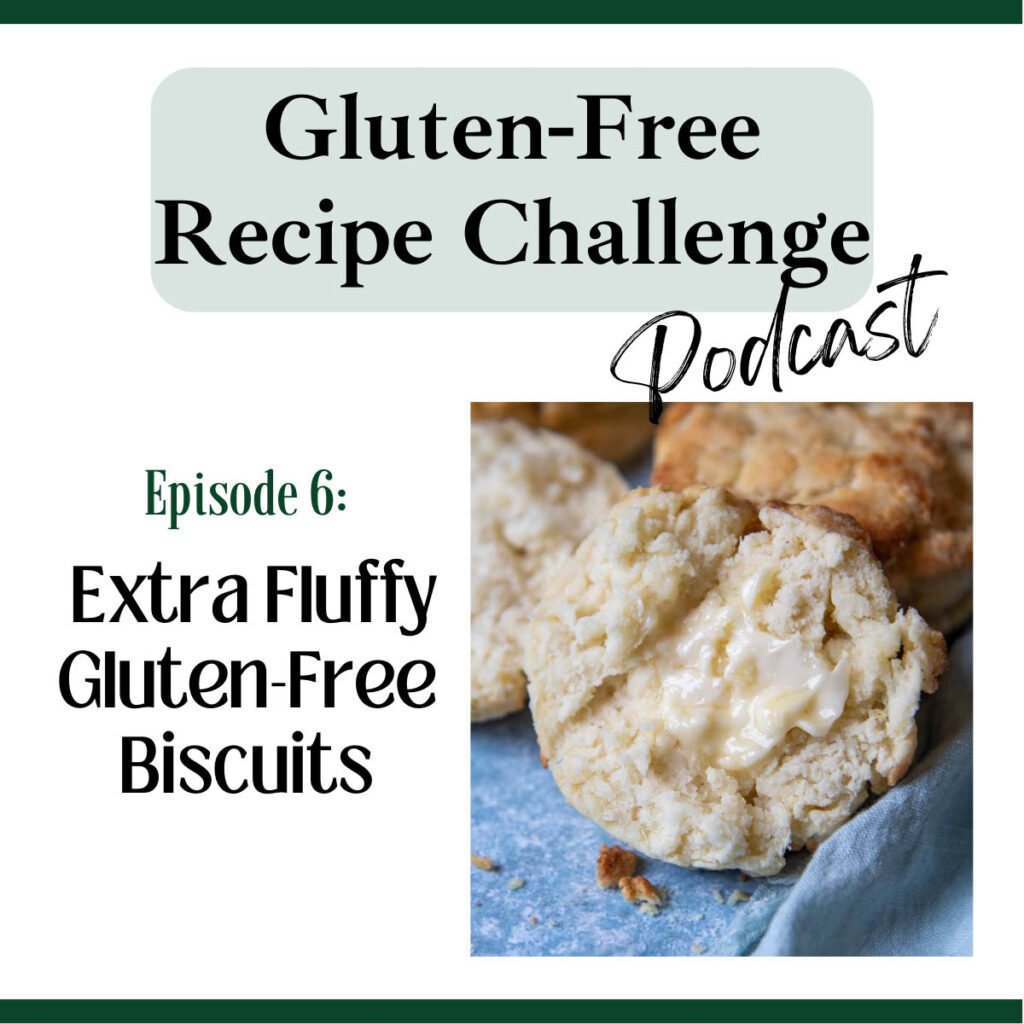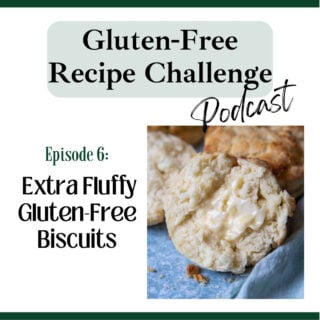In episode 06 we learn how to make fluffy gluten-free biscuits made with simple ingredients to replicate a buttery southern-style drop biscuit! These light and tender biscuits require no shaping or rolling, so even the novice baker can make them effortlessly. Join Melissa as she shares many easy, pro tips, plus the best ingredients and methods for success. This audio recipe for gluten-free biscuits will transform you into expert gluten-free baker.

Listen to this episode, along with the full audio library, on iTunes, Spotify, Stitcher, TuneIn, or your favorite podcast player.
Recipes and Resources Mentioned
- Gluten-Free Biscuits
- Ultimate Gluten-Free Flour Resource
- Gluten-Free Cheese Scones
- Gluten-Free Shortcake
- Gluten-Free Sausage Gravy
- America’s Test Kitchen: How Can It Be Gluten-Free Cookbook
Recommended Equipment
Recommended ingredients
Follow Along
Don’t forget to subscribe to our weekly newsletter! Besides receiving an immediate GLUTEN-FREE BAKING BONUS, this weekly newsletter gives you direct access to the newest recipes, helping you with menu planning and exclusive tips!
Transcript
Hey everyone. I’m Melissa Erdelac, host of the Gluten-Free Recipe Challenge podcast and creator behind the gluten-free website, Mamagourmand. Here we take beloved recipes you thought you’d never enjoy again and transform them into easy copycat versions, just as good as the originals. This is your gluten-free recipe rehab.
Today we’re gonna make like Digital Underground and grab them in the biscuits. Can’t talk about biscuits without thinking about the Humpty Dance. My apologies. So let’s get our biscuit on. More specifically, let’s get some fluffy ass GF biscuits on.
This recipe came from the cookbook that I talked about in the pie crust episode which was episode two and it’s from the cookbook, America’s Test Kitchen: How Can It Be Gluten Free? This is something that was my lifesaver when I started out gluten free baking, and I will link to it in the show notes.
It has a ton of really great basic recipes and gives a lot of explanations about why they choose the ingredients they do and the methods they do. So this recipe, the biscuits, is from that cookbook, but I’ve made the recipe a lot more straightforward and streamlined because I’ve just made the recipe so much. I kind of tested the limits of how far you could go and push it in terms of ingredient swaps and shortcuts.
The great thing about these biscuits, besides the texture and the taste of them, is there’s no rolling, there’s no shaping. It’s just a simple drop biscuit. So you mix the dough together and I use a grease measuring scoop to drop the biscuit dough onto the baking sheets. You don’t need any fancy equipment for, you don’t even need a stand mixer, and it’s a great recipe if you’re a novice baker or just getting into gluten-free baking.
Let’s talk about what you need for this recipe. Two aluminum baking sheets, and these are the heavy duty aluminum baking sheets, not the chintzy ones. If you don’t have some good baking sheets, I would actually just spring for them.
They’re not very expensive and they really make a difference . They conduct the heat evenly and disperse it so your things are evenly browned at the bottom. It doesn’t have hotspots and it kind of retains the heat true to what the oven temperature is.
I also use a pastry blender for this recipe, which is just this half moon utensil with almost like whisk edges in it.
If you don’t have a pastry blender, you could just use a fork or your fingers too. It’s not necessary for it. It’s kind of just more ergonomic of working the butter into the dough. And that’s it as far as equipment, mixing bowls, measuring cups, your baking sheets, pastry blender. I also use parchment paper. I would use that to put the biscuits on just so they don’t stick at all.
In terms of ingredients for the flour, I’m gonna go on my Cup4Cup spiel again, but it really yields the best results in this recipe. I’ve tested it with several other gluten-free flours, and you can see the results on that.
I have a gluten-free flour comparison post on my website where I test different cookies, biscuits, breads with the top brands, and you can see how they compare. In blind taste tests with my family and friends, the Cup4Cup really outperformed the other ones. A solid runner up for this recipe in particular would be King Arthur’s Measure-for-Measure gluten-free flour.
But I do not recommend Bob’s Red Mill for it. It just makes the biscuits really heavy and dense.
For the fat for the recipe, you are gonna use a combination of butter and oil. And this is a little atypical of biscuits recipes. Usually wheat flour biscuits are just all butter, but there’s a reason why we use butter and oil in gluten-free biscuits, and that is because gluten-free flours don’t absorb fat as well.
If you use all butter for this recipe, they will become overly greasy and the texture just won’t be as fluffy as you would hope it to be. So the cold butter, we use it because it does add flavor, but the oil helps to evenly coat the starches. The cold butter can’t really disperse over the starches as well as the oil does. So we use the butter for flavor and then we use the oil to coat the starches and soften them, which also makes them less gritty when you taste it.
The other kind of unusual ingredient we use in this recipe is yogurt. Usually biscuits use buttermilk. But the other great thing about gluten-free starches is they don’t absorb liquid as well. So if you use buttermilk, it makes the biscuit spread too much. The yogurt keeps that tang of the buttermilk, but also maintains the structure of the biscuit.
Basically it’s adding the flavor while keeping the biscuits tall and fluffy instead of thinner and spread out. And here’s where I’ve really tested the limits of substitutions for this. Originally the recipe calls for full fat, whole milk yogurt, which I would say is probably your number one choice, but I don’t always have that in my fridge.
I’ve used everything for this. I’ve used low fat yogurt. I’ve used vanilla yogurt. I’ve used sour cream. If you wanna get really crazy, you could use flavored yogurt and use these biscuits for a shortcake. But let’s just say whole milk yogurt’s the best. But if you need a biscuit , then use what’s in your fridge in terms of any yogurt or sour cream.
You also add an egg to this, which doesn’t typically get added in biscuit recipes, but just for gluten-free baking, that egg acts as a binder, which is always helpful, so your biscuits don’t crumble apart when you eat them.
The other ingredient you’ll need is lemon juice, and this helps tenderize the dough, but it also replicates that buttermilk taste. With the addition of the yogurt and the lemon juice, it makes it taste like they’re buttermilk biscuits without using buttermilk. But I’ll tell you a lot of times, I’m too damn lazy to squeeze a lemon, so I just use vinegar or apple cider vinegar in its place cuz you only need two teaspoons of lemon juice.
It’s a lot easier for me to just pour a little bit of vinegar and then, you know, go through the hoopla of what lemons require.
The last ingredient I wanna talk about is the baking powder. You need four teaspoons of baking powder and sometimes I get comments that with recipes that use a lot of baking powder, they say that it’s metallic tasting, and this is because your baking powder is not aluminum free.
There’s aluminum free baking powder, and then there’s baking powder with aluminum in it. For biscuits, you need a lot of baking powder, uh, muffins usually use a lot of baking powder too. For recipes that use a lot of baking powder, make sure that it’s aluminum free and this will prevent any metallic taste.
They add aluminum into baking powder, so it’s heat activated. Cuz normally when you put baking powder with any liquids, that’s when it starts to activate. Some brands add aluminum so it doesn’t activate, then it’ll activate when it goes in the oven. But it also affects the taste negatively. Since these biscuits sit a little bit before we bake them, we also add a little bit of baking soda too, to just counteract with the baking powder sitting for a while before they go in the oven.
Okay, let’s get our biscuit on. We are gonna whisk together two cups of gluten-free all-purpose flour, four teaspoons of baking powder, one teaspoon of sugar. A half a teaspoon of salt and a fourth a teaspoon of baking soda. You’re gonna whisk that together in a large bowl. Then take three tablespoons of chilled butter and for the butter, you don’t wanna put it all in one solid hunk.
You cut it up in little pieces before adding it to the flour mixture. This is when you use your pastry blender, or you could use your fork or your fingers to work the butter into the flour. You want work it in until the flour will kind of clump together in like little pea size pieces. So you don’t want a lot of solid butter and then a bunch of flour.
You want to work it together so it’s incorporated evenly. And if you wanna see what that looks like, I would go to the recipe post and there’s a picture of it, what your dough should look like at that point. So set that flour mixture aside, and then take a small bowl and whisk together three-fourths cup of yogurt, one egg, two tablespoons of oil, and two teaspoons of lemon juice. Or if you’re lazy, vinegar.
Dump the yogurt mixture into the large bowl with the flour and butter mixture, and then use a spoon and stir that together. Stir it together and work the dough until you don’t see any flour pockets. You want it to be evenly moist throughout.
At this point, cover the bowl with plastic wrap and let it sit for 30 minutes. No more, no less. 30 minutes is the sweet spot. And you may be wondering, do I have to let it rest? Can I just bake this right away?
Well, yes, but no. If you bake them right away, you’ll get a grittier texture and they won’t be as soft as you’d like them. And also the dough’s gonna be a little bit harder to work with. As the flour and the moisture sits together, the dough becomes more workable because it gives time for the gluten-free flour to absorb the moisture, and it also allows time for the starches to relax, making your biscuit softer and fluffier.
While they’re sitting, clean up all your shit, wash the dishes, and then preheat the oven to 425.
Now we’re ready to drop the biscuits and bake them. And this is when you do something a little bit weird that you probably haven’t done before. I said before, you need two baking sheets because you put one baking sheet on top of the other so they’re nested together.
You do this because the biscuits bake at a really high oven. They bake at 425, and if you just used one baking sheet, the bottoms would become really brown and possibly burnt while the tops wouldn’t be cooked through all the way. Using a double layer of baking sheets helps insulate the heat. The top cooks at the same rate as the bottom.
Stack two baking sheets together and then put a piece of parchment paper on top, so the biscuits release easily. If you don’t have parchment paper, you could use non-stick cooking spray.
Now we need to drop the biscuits onto the baking sheet. Take a one third measuring cup and grease it with non-stick cooking spray, and then put the measuring cup in the bowl and scoop out the dough. You want the dough to be even , so a level one third cup of dough. And you don’t wanna press down too hard on the dough because you don’t wanna be too compact.
But you also don’t want it to be too loose because then the dough will break apart. It’s kind of like a sweet spot of making sure the dough’s all smushed together, but not too compressed. Turn the measuring cup over onto the baking sheet, and because of the non-stick cooking spray, it’ll release easily and place it on your prepared pans.
This recipe makes seven biscuits, and when you are placing the biscuits on the baking sheet, put one in the center and then you kind of wanna put the other ones like, I guess like flower petals or like an orbit around the center one. And you want them close together, no more than an inch apart.
And the reason we do this is because as they cook, since they’re so close together, it traps the steam in between the biscuits and it makes them more tender. So it’s kind of like a little biscuit sauna, but without all the naked awkwardness.
When you’re putting the dough onto the baking sheet, you’ll probably have to spray your measuring cup a few times. If you find that it’s sticking to the measuring cup, just spray it again, and it should release easily.
Position your oven rack in the middle and bake them for 15 to 17 minutes, and you wanna make sure that you rotate the pan halfway through, especially because the oven is such a high temperature.
And this would be another reason, if you listen to episode four, why it’s a good thing to have a cheap ass oven thermometer in your oven at all times because you really wanna make sure the temperature’s accurate for this. If your oven is cooking too low, it’ll take too long to rise, and if it’s too fast, then you’ll get the burnt bottoms with out being cooked through in the center. Make sure it’s an accurate 425.
Once they’re done baking, you take them out and just let them sit on the baking sheet for about five to 10 minutes and then they’re ready to serve.
These biscuits are best the day they are made. Just like any other gluten-free bread, they have a tendency to dry out quickly.
If you’re not going to eat them or serve them that day, then I recommend freezing them. To do this, wrap each biscuit in plastic wrap to prevent ice crystals from forming and put them in a Ziploc freezer bag up to three months.
If you are going to eat them that day, and just wanna store them for a few hours, put them in after they’ve cooled completely, make sure they’ve cooled completely. Put them in an airtight container.
Since these are relatively quick to make, this is the thing that I have all the time in my freezer when I need bread for soups or just something else that my family is eating. Something that I don’t wanna be angry about that I’m not eating. I will pull out one of these biscuits from the freezer.
You could defrost at room temperature for an hour, but I’m usually not that ahead of the game, so I just wrap them up in a paper towel and put them in the microwave at 50% power for about 30 seconds to 60 seconds until they’re nice and warm.
The other great thing about this recipe is you can adapt it for different flavors. On my website, I have a recipe for gluten-free cheese scones, which I add garlic and sharp cheddar cheese too, so they turn into the Red Lobster biscuits. I also have a recipe for shortcake where I use this recipe and add more sugar to the dough and then sprinkle the tops with sugar. And I use that for strawberry shortcake.
You can mix in fresh or dried herbs to it, different types of cheeses. Use them for a cobbler topping, biscuits and gravy, or just add some fresh berries to them.
Okay, so that’s all for this recipe. Remember, you can always find the full printable recipe on the show notes page, and to get to that, you just click on the link provided in whatever podcast app you’re listening on. You can also go to my recipe website, mamagourmand.com and click on the podcast tab.
On the show notes page, you’ll find the full recipe along with any tips I’ve mentioned along with the recommended ingredients and equipment I’ve talked about.
Also, if you’re loving the show, I’d be so appreciative if you could rate and leave me a comment on your podcast app. That really helps. Don’t forget to follow or subscribe to the show so you never miss a new episode.


Leave a Reply